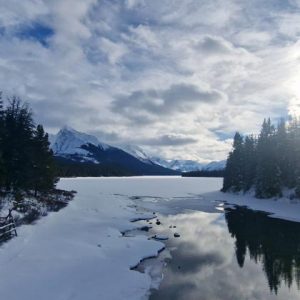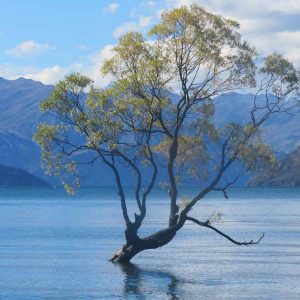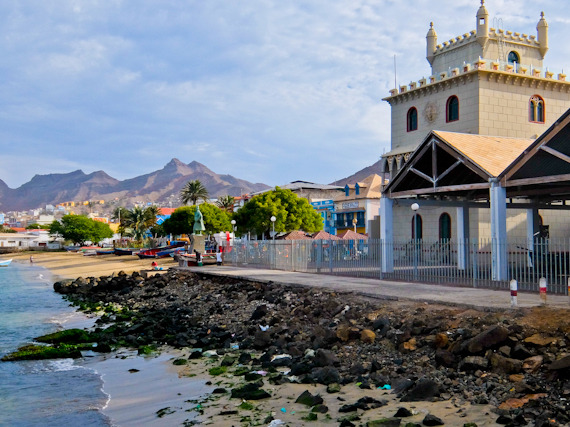 Around 1000 miles south of the Canaries, in the Atlantic Ocean, the Cape Verde Islands make a great winter destination and are particularly suited to walkers.
Around 1000 miles south of the Canaries, in the Atlantic Ocean, the Cape Verde Islands make a great winter destination and are particularly suited to walkers.
Unfortunately there are no direct scheduled flights to Cape Verde and you have to fly via Lisbon, unless you’re taking a charter to the touristy islands of Sal and Boa Vista. These are not much more than windblown lumps of sand and the others have more interest. Originally colonised by the Portuguese in 1462, independence was only granted in 1975, and for the first few hundred years the slave trade was the main activity. After that, the islands became a coaling station for steam ships on the way to the Americas, but nowadays it’s tourism which is the main breadwinner. These are islands created by undersea volcanic activity and there’s still in an active volcano on Fogo, although on the others, it’s only the extinct craters that remain.
Santiago
I arrive from Lisbon in Praia, the capital of Santiago, and am taken straight to my hotel. This was the first island to be colonised and next day I’m on my first walk, an easy amble down a fertile valley to the old capital Cidade Velha. 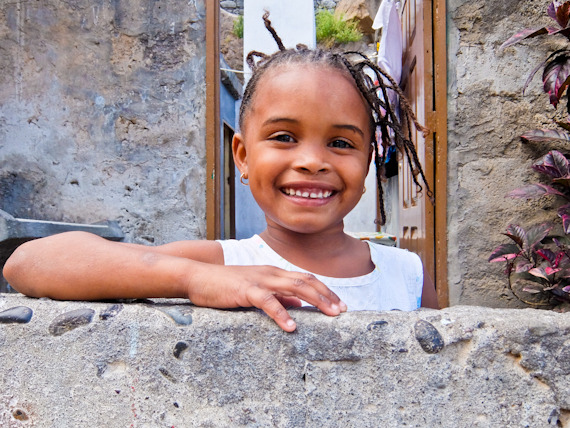 On the way I pass ramshackle shacks, distilling Grogue, the local rum, from sugarcane and even get a taste. Cidade Velha, founded in 1462 is on the sea and is now a UNESCO heritage site because of its cathedral, churches and fort, commanding the hillside above. Pirate attacks meant that Praia became the capital in 1770 but much restoration work is ongoing here and it’s delightfully free of tourists.
On the way I pass ramshackle shacks, distilling Grogue, the local rum, from sugarcane and even get a taste. Cidade Velha, founded in 1462 is on the sea and is now a UNESCO heritage site because of its cathedral, churches and fort, commanding the hillside above. Pirate attacks meant that Praia became the capital in 1770 but much restoration work is ongoing here and it’s delightfully free of tourists.
The toughest walk on the island is up to the highest point, Pico do Santo Antonio at 1392m. My guide tells me that recent rain has made it dangerous but I’m keen to press on. We start at the military communications station, descend slightly then begin the long climb. Visibility is perfect and it’s easy to make out the volcano on Fogo, the next island. Unfortunately it’s also rather hot and the climb gets steeper and other members of our party begin to drop out. Finally, within perhaps half an hour of the summit, we also have to admit defeat.
Sao Vicente
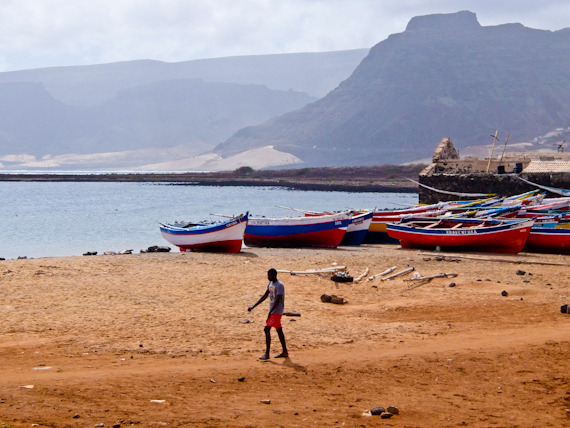 I’m up before dawn for the one hour flight north to Sao Vicente. Mindelo, the capital, has a natural harbour, utilised by the British in the 19th century to resupply steam ships on their way to the Americas and South Africa. As a result the town became rich, evident in its many opulent colonial buildings, before lapsing into decay when ships switched to oil or started to use the Suez Canal. These days it seems to have a new lease of life and it’s an attractive place to wander around. At night bars and restaurants often have live music, often the local “Morna” made famous by singer Cesaria Evora, Cape Verde’s most famous export. The rest of the island is barren volcanic mountainous rock, striking in its desolation, but it’s worth a trip to Monte Verde, at 750m often hidden in mist.
I’m up before dawn for the one hour flight north to Sao Vicente. Mindelo, the capital, has a natural harbour, utilised by the British in the 19th century to resupply steam ships on their way to the Americas and South Africa. As a result the town became rich, evident in its many opulent colonial buildings, before lapsing into decay when ships switched to oil or started to use the Suez Canal. These days it seems to have a new lease of life and it’s an attractive place to wander around. At night bars and restaurants often have live music, often the local “Morna” made famous by singer Cesaria Evora, Cape Verde’s most famous export. The rest of the island is barren volcanic mountainous rock, striking in its desolation, but it’s worth a trip to Monte Verde, at 750m often hidden in mist.
Santo Antao
It’s only an hour on the ferry but this island couldn’t be more different, fertile and green as a contrast to barren and black. It’s a hiker’s paradise with enough trails in the North East of the island to occupy you for a week or more. I’m dropped at Cova de Paul, the extinct volcano, for my first walk which is downhill all the way to the coast. 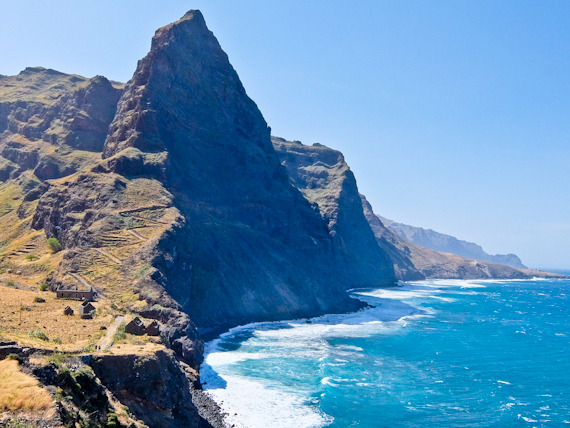 I cross the fertile crater packed with orange trees, sugar cane, tomatoes and a few houses then hit a finely crafted winding cobbled path, bounded by drystone walls. Villages cling to every available ledge and the scenery reminds me of the foothills of the Himalayas in Nepal. I pass through coffee groves, the growers selling their beans, then guava and mango plantations, before reaching the sea at Cidade das Pombas.
I cross the fertile crater packed with orange trees, sugar cane, tomatoes and a few houses then hit a finely crafted winding cobbled path, bounded by drystone walls. Villages cling to every available ledge and the scenery reminds me of the foothills of the Himalayas in Nepal. I pass through coffee groves, the growers selling their beans, then guava and mango plantations, before reaching the sea at Cidade das Pombas.
My drive to the Hotel Pedracin Village takes me along the coast, past steep black cliffs with the foaming sea below, before climbing up another fertile valley. It’s in a beautiful quiet location, surrounded by mountains and they even have a small swimming pool. Next day, the second walk skirts the side of the hillside with constant views of the cliffs and churning sea. Centuries of work has built terraces, some abandoned, but others still home to mango, papaya, cassava, bananas and coffee. The track I take is the one single route between villages, and the only other people on the trail are locals carrying goods on their heads. Some of the houses have been abandoned, apparently because of lack of water, but the terraces are still being worked. At the end it’s a steep descent to the coast at Sinagoga, named because of its Synagogue, now ruined, and built by Jewish immigrants a few hundred years ago.
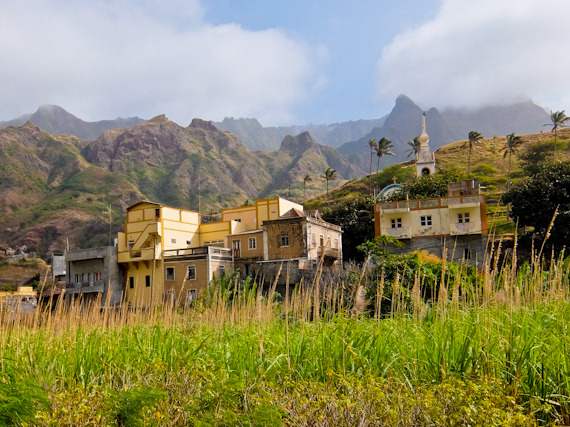 The final walk follows the Northern coast from Cruzinha da Garca to Ponta do Sol. It’s up and down, sometimes descending to sea level, then suddenly climbing up the side of steep cliffs, the path hacked out of the bare rock. The views are stunning and there are more hikers on this walk, but it doesn’t distract from the natural beauty. After about five hours I reach Ponta do Sol, straddling the flat tip of the peninsula, and one of the oldest settlements. Its large main square is home to an imposing town hall and a large church, with an abandoned airport beyond. This is part of the attraction of Santo Antao since it only attracts intrepid tourists.
The final walk follows the Northern coast from Cruzinha da Garca to Ponta do Sol. It’s up and down, sometimes descending to sea level, then suddenly climbing up the side of steep cliffs, the path hacked out of the bare rock. The views are stunning and there are more hikers on this walk, but it doesn’t distract from the natural beauty. After about five hours I reach Ponta do Sol, straddling the flat tip of the peninsula, and one of the oldest settlements. Its large main square is home to an imposing town hall and a large church, with an abandoned airport beyond. This is part of the attraction of Santo Antao since it only attracts intrepid tourists.
I travelled with HF Holidays and most of my small group were over 60, with a handful in their 70s. Walks are full and part day, between three and miles, with up to 2150 feet of ascent, and there’s also some sightseeing. You need to be fairly fit for this holiday, but the pace is leisurely and everyone seem to manage.
Cape Verde with HF Holidays
Enjoy the dramatic beauty and cultural vibrancy of three very diverse islands, with their fascinating mix of African and European laid-back island atmosphere.
Prices include:
- Full Board with ensuite accommodation.
- A full holiday programme with an HF Holidays’ leader and local guides.
- ‘With flight’ holidays include return flights from the UK and hotel transfers.
- All transport, internal flights and tips.
For more details or to request a brochure visit HF Holidays.
Silver Travel Advisor recommends HF Holidays


